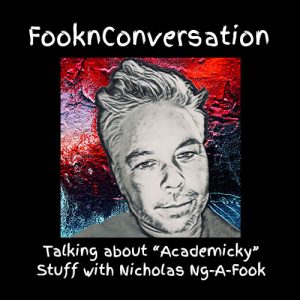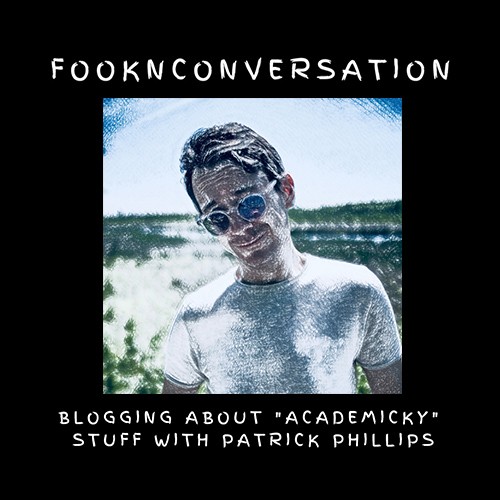
A blog By Patrick Phillips.
In 2019 Dr. Erica Dodds, chief operating officer at the Foundation for Climate Restoration, ran a “climate reality” workshop for a Washington, D.C. high school. She asked students, “What would life look like in 30 years?” The answers were not idyllic vistas of a prosperous world. In fact, “the answers weren’t pretty” (Grist, 2019, n.p.). As a millennial educator and curriculum scholar, I can relate to these students’ responses. In the face of the existential threat of a global climate crisis, the future pictures my mind paints of the Earth’s biosphere are quite bleak. In many of them, I am dead, and so is my reader.
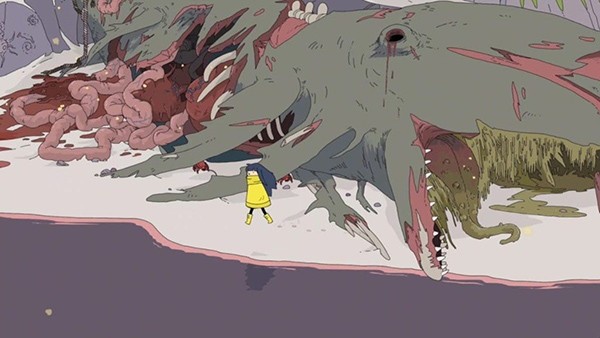
Ironically, although we live in a universe where we are in charge, all we see on the horizon is our end.
— Robert Joustra and Alissa Wilkerson (2016)
People have been dealing with [death] for a long time, and it is something you can’t avoid in the end.
— Stephen Perkinson, Associate professor of art history at Bowdoin College (qtd. in Alleyne, 2017)
The question is: What do you do with that?
In Teaching the Climate Crisis: Existential Considerations, Cathryn van Kessel (2020) offers Terror Management Theory (TMT) as a relational model that layers onto–or seeps down through–the landscapes of our course discourse so far. In many ways, we have been reading and writing about the dilemmas of teaching and learning amidst worldview threat. Lindsay Gibson’s (2018) historical thinking models ethical engagement with difficult histories that challenge our identities and responsibilities as citizens of a nation born of violence. Gibson’s (2018) conceptual framework for ethical judgment connects teacher students with the considerable task of addressing the Truth and Reconciliation Commission’s Calls to Action (2019, p. 253.). Like Gibson’s project of reconciliation between history and education, we, as curriculum scholars, are tasked with stewarding a future for our field while attempting to affect inequitable systems and structures. Dwayne Donald (2009; 2012) reminds us that some of these structures are deeply pervasive and remain blind spots in our theorizing. In kind, Hongyu Wang’s (2019) pedagogies of interconnectedness call on us to challenge ourselves and concede our attachments to the violent borders of our unconscious individualism that might thwart a real reciprocal sense of care for each other.
The educational proposition of teaching amidst worldview threat is akin to what Britzman (1998) has called elsewhere difficult knowledge, which calls on teachers and students to work through emotional terrains. Difficult knowledge burdens teachers and students with an overwhelming affective task fraught with crisis and trauma (van Kessel, 2020, p. 131). However, as a millennial student, scholar, and educator, I would add that the task of teaching for, with, and against the climate crisis–if it is also to carry the burden of future recovery—is infused with grief. In theorizing elsewhere how to support learners’ public engagement with traumatic histories of mass human violence, Aparna Mishra-Tarc (2020) draws our attention to a feeling similar to what I felt in high school when reading about global warming and its projected future effects:
Grief precedes all emotion—it is the grounds for a hard-fought existence forcibly coming out of another into ourselves. We are born stricken with loss, knowing that something is not quite right where we are found. We come into the world without membership in a pre-formed society, subject to conditions these strange grown up beings place on our tiny bodies. We come into or out of ourselves again in school, as children. (p. 35)
— Aparna Mishra-Tarc (2020)
Mishra-Tarc (2020) writes of grief in the context of reparative literacy curriculum, for “children left behind by parents, separated at borders, stranded at sea,” and those–including our vulnerable past selves–who “are made to occupy sexual and social identities, positions, and cultural morays that resemble little of the way we feel and want to be inside” (p. 35). While Mishra-Tarc’s consciousness of grief is akin to an affective, psychoanalytic historical thinking, teaching and learning the climate crisis asks us to look forward toward a potentially bleak future of scorching sun and withered crops, left behind in the dustbowls of neoliberal hubris, and grieve.
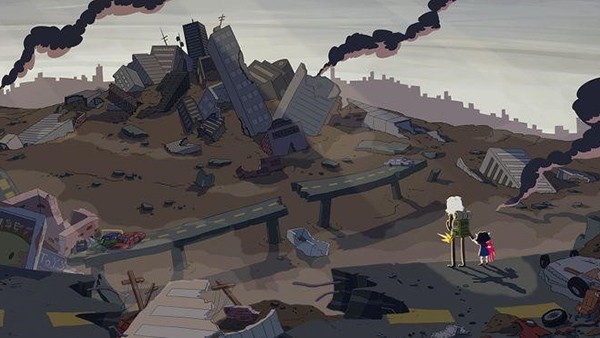
Grief over my fate is my psychical defensive move against the existential threat posed by the difficult knowledge of the climate crisis. It is arguably shared by many North American students. Voter surveys by the Environmental Voter Project and analyses by the Pew Research Centre and American Psychological Association suggest that a fatalistic worldview, in the face of the climate crisis, is perhaps normal for many young Western people. The emotional well-being of 72% of Americans under 45 is significantly affected by “eco-anxiety,” along with historically low faith in capitalism. Many young people today, in planning for their future, “think civilization may not exist when they’re of retirement age” (Kari, 2019). This is an everyday worldview of grief over each of our own foreclosed futures.
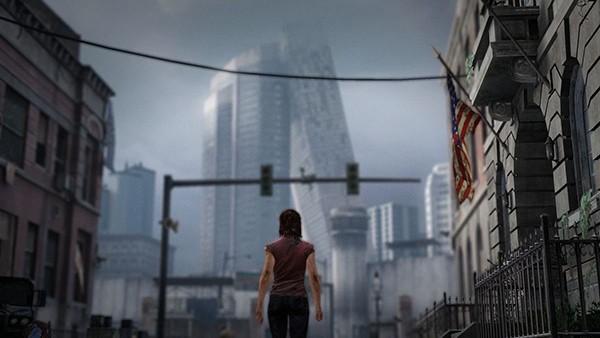
Donald (2012) argues elsewhere that we are forging ahead in curriculum studies while actually still missing a human relationality that respects and so actually includes Indigenous worldviews. I understand that this ethical relationality would therefore include humans as part of a spiritual ecology. An application of TMT, as van Kessel (2020) maintains, acknowledges that teaching the climate crisis brings us face-to-face with our “lack of control to stop climate [catastrophe, destabilizing] assumptions that humans are exempt from relationality with the rest of the planet” and can leave us with “deep-seated annihilation anxiety” (p. 136). However, what if this is not a denial of ecological dependence, but instead fatalistic acceptance? TMT, as a theory designed to critically question assumptions about reality that “infuse human existence,” could be coding our eco-anxieties as defense mechanisms. Curiously, van Kessel notes that the primary source for our existential worldviews are from culture, “i.e., constructed symbolic conceptions of reality shared by a group” (p. 132). While van Kessel’s outline for reaching students through eco-anxieties does mention associated defensive moves like reduced reading comprehension, van Kessel leaves unnamed what might be the most mortally-salient worldview in Western culture: fatalism.

The suffusion of an ever-present awareness of future demise is not new to Western culture. The images I have woven into this response have so far been demonstrative of the post-apocalyptic worldview infused across Western narrative and visual culture–in which van Kessel’s students live. I suggest that it is this cultural worldview that informs my encounter with global ecological collapse, and which may be an unexplored challenge and opportunity for both TMT and reparative curriculum. The image directly above is of a medieval European boxwood miniature. Below is another, more overt in its status as a mytho-spatio pedagogy of existential terror. These tiny reminders of death were valued as spiritual anchors to fateful acceptance, in a time when death could take one at any moment–by violence, plague, or even a tiny scratch. Coupled with emerging capitalism, however, these seeds of faith succumbed to their material value, and now they are valuable objets d’art.
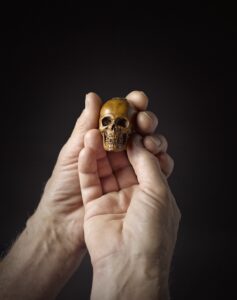
Prayer Bead in the Form of a Skull: The Entry into Jerusalem Carrying of the Cross (c.1480–1500). 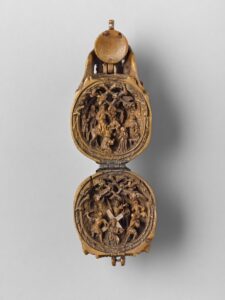
Thomson Collection at the Art Gallery of Ontario. (#29283). http://boxwood.ago.ca/
Religious studies student-scholar Sarah Ertelt (2018) at DePauw University argues that this fatalism remains infused within Western culture. It has in our era become a “secular apocalyptic religion” (p. 6). Through medieval times to cold-war nuclear proliferation, in which apocalypse could “occur at any time without the helping hand of God,” Western worldviews have truncated humanity’s ethical responsibility to the future. Dominant worldviews continue to be locked into short-termism, now via climate fatalism (p. 3-5). I see this secular apocalyptic infused in van Kessel’s necrocene, through the stories and symbologies we live through–from mushroom cloud to desolate wasteland. In short, echoing Hongyu Wang (Wang, 2019, Nicholas Ng-A-Fook, 2020), if my own future is one of violent destruction, why care about averting yours?
And yet, van Kessel’s contextualisation of TMT carries another kind of seed, perhaps a miniature of hope. In juxtaposing the potential of anthropocentric Eurocentric worldviews turning to Indigenous models of relationality, van Kessel suggests that we may take up the “[call] for a recognition of communities that include entities like soil and water” (2020, p. 135). Indeed, what I am left with are the contours of an axiological void (Donald, 2012) that a typical North American curriculum would struggle to fill, if not outright culturally disqualify (Donald, 2009). And so. I ask: if we are entities of land and water, where is the faith in ourselves?
References:
Art Gallery of Ontario (n.d.) The Boxwood Project. Virtual educational exhibition. http://boxwood.ago.ca/
Allyene, A. (2017, October 31). How a macabre reminder of death became a Renaissance status symbol. CNN. Retrieved from: https://www.cnn.com/style/article/memento-mori-ivory-mirror/index.html
Byford, S. (2014, August 1). POST-APOCALYPTIC PHOTOGRAPHY WITH ‘THE LAST OF US’ ON PS4: If video games are art, can they also be cameras?. The Verge. Retrieved from https://www.theverge.com/2014/8/1/5958249/the-last-of-us-remastered-photo-mode
Costa, R. (2019, August 9). Minute of Islands looks like Adventure Time drawn by Moebius: A cool conjunction. PCInvasion. Retreived from https://www.pcinvasion.com/minute-of-islands-looks-like-adventure-time-drawn-by-moebius/
Donald D. (2012) Forts, Curriculum, and Ethical Relationality. In: Ng-A-Fook N., Rottmann J. (eds) Reconsidering Canadian Curriculum Studies. Curriculum Studies Worldwide. Palgrave Macmillan, New York
Donald, D. (2009). Forts, curriculum, and Indigenous Métissage: Imagining decolonization of Aboriginal-Canadian relations in educational contexts. First Nations Perspectives, 2(1), 1-24.
Ertelt, S. (2018). “Nuclear Alarmism and Climate Change Fatalism as a Secular Apocalyptic Religion”. Part of the Religious Thought, Theology and Philosophy of Religion Commons, and the Sociology of Religion Commons. DePauw University student research https://scholarship.depauw.edu/studentresearch/83
Grist Creative (2019, August 27). For young people, restoring our climate means restoring hope. Grist. Retrieved from: https://grist.org/article/for-young-people-restoring-our-climate- means-restoring-hope/
Joustra, R. Wilkerson, A. (2016) How to Survive the Apocalypse: Zombies, Cylons, Faith, and Politics at the End of the World. William B. Eerdmans Publishing.
Kari, P. (2019, August 4). Young people blame climate change for their small 401(k) balances. MarketWatch. Retrieved from https://www.marketwatch.com/story/how-to-get-young-people-to-save-for-the-future-when-they-think-the-planet-is-doomed-2019-05-23
Mishra-Tarc, A. (2020). Engaging Texts Today or How to Read a Poem. Journal of Curriculum Theorizing, 35(1), pp. 32-45.
Ng-A-Fook, N. (2020). Episode 3: Hongyu Wang. Fookinconversation. Podcast. https://www.fooknconversation.com/podcast/episode-03-hongyu-wang/
Ng-A-Fook, N. (2020). Episode 1: Dwayne Donald. Fookinconversation. Podcast. https:// www.fooknconversation.com/podcast/episode-1-dwayne-donald/
Russo, L. (2020, May 2). D&D: How to Recreate the World of Adventure Time for Your Next Campaign. CBR. Retrieved from https://www.cbr.com/dd-recreate-adventure-time-next-campaign/
Van Kessel, C. (2020). Teaching the climate crisis: Existential considerations. Journal of Curriculum Studies Research, 2(1), 129- 145. https://doi.org/10.46303/jcsr.02.01.8
Wang, H. (2019). An Integrative Psychic Life, Nonviolent Relations, and Curriculum Dynamics in Teacher Education. Studies in Philosophy and Education 38, pp. 377–395.

